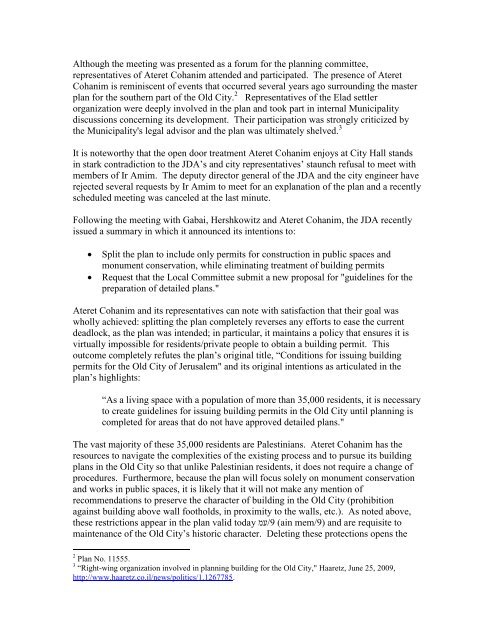Old%20City%20Master%20Plan_0
Old%20City%20Master%20Plan_0
Old%20City%20Master%20Plan_0
Create successful ePaper yourself
Turn your PDF publications into a flip-book with our unique Google optimized e-Paper software.
Although the meeting was presented as a forum for the planning committee,<br />
representatives of Ateret Cohanim attended and participated. The presence of Ateret<br />
Cohanim is reminiscent of events that occurred several years ago surrounding the master<br />
plan for the southern part of the Old City. 2 Representatives of the Elad settler<br />
organization were deeply involved in the plan and took part in internal Municipality<br />
discussions concerning its development. Their participation was strongly criticized by<br />
the Municipality's legal advisor and the plan was ultimately shelved. 3<br />
It is noteworthy that the open door treatment Ateret Cohanim enjoys at City Hall stands<br />
in stark contradiction to the JDA’s and city representatives’ staunch refusal to meet with<br />
members of Ir Amim. The deputy director general of the JDA and the city engineer have<br />
rejected several requests by Ir Amim to meet for an explanation of the plan and a recently<br />
scheduled meeting was canceled at the last minute.<br />
Following the meeting with Gabai, Hershkowitz and Ateret Cohanim, the JDA recently<br />
issued a summary in which it announced its intentions to:<br />
� Split the plan to include only permits for construction in public spaces and<br />
monument conservation, while eliminating treatment of building permits<br />
� Request that the Local Committee submit a new proposal for "guidelines for the<br />
preparation of detailed plans."<br />
Ateret Cohanim and its representatives can note with satisfaction that their goal was<br />
wholly achieved: splitting the plan completely reverses any efforts to ease the current<br />
deadlock, as the plan was intended; in particular, it maintains a policy that ensures it is<br />
virtually impossible for residents/private people to obtain a building permit. This<br />
outcome completely refutes the plan’s original title, “Conditions for issuing building<br />
permits for the Old City of Jerusalem" and its original intentions as articulated in the<br />
plan’s highlights:<br />
“As a living space with a population of more than 35,000 residents, it is necessary<br />
to create guidelines for issuing building permits in the Old City until planning is<br />
completed for areas that do not have approved detailed plans."<br />
The vast majority of these 35,000 residents are Palestinians. Ateret Cohanim has the<br />
resources to navigate the complexities of the existing process and to pursue its building<br />
plans in the Old City so that unlike Palestinian residents, it does not require a change of<br />
procedures. Furthermore, because the plan will focus solely on monument conservation<br />
and works in public spaces, it is likely that it will not make any mention of<br />
recommendations to preserve the character of building in the Old City (prohibition<br />
against building above wall footholds, in proximity to the walls, etc.). As noted above,<br />
these restrictions appear in the plan valid today מע/9 (ain mem/9) and are requisite to<br />
maintenance of the Old City’s historic character. Deleting these protections opens the<br />
2 Plan No. 11555.<br />
3 “Right-wing organization involved in planning building for the Old City," Haaretz, June 25, 2009,<br />
http://www.haaretz.co.il/news/politics/1.1267785.


